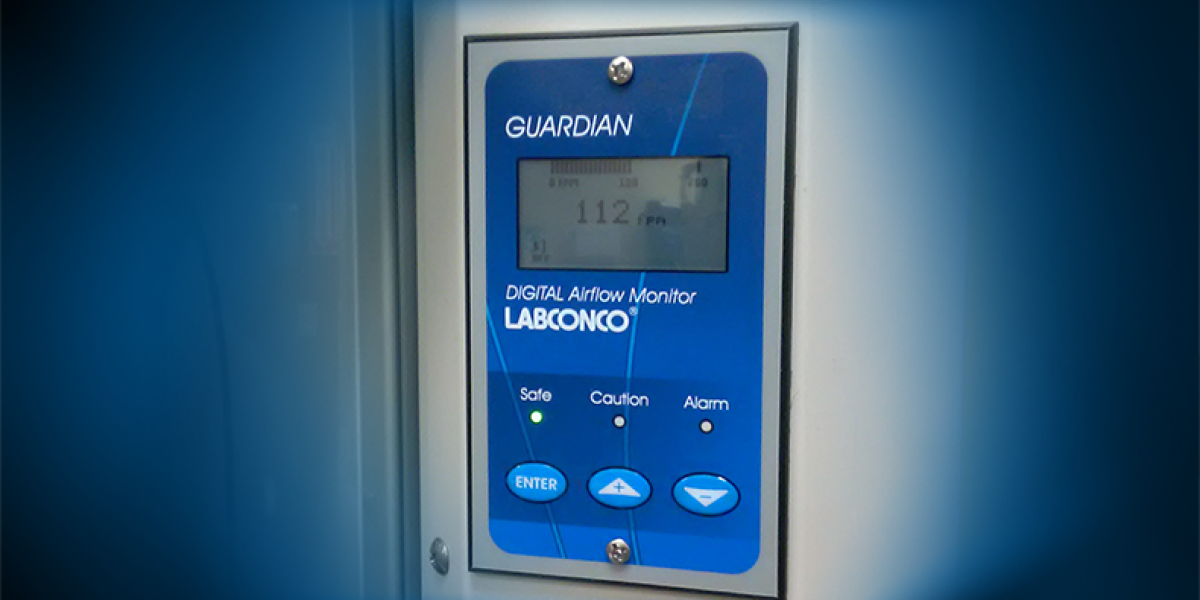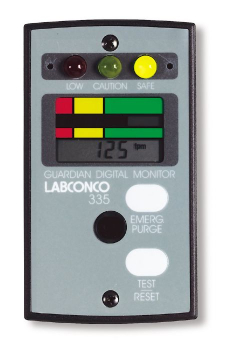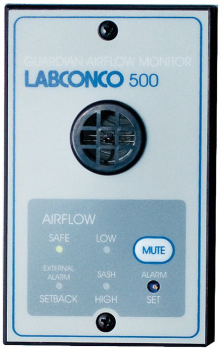4 things you need to know about airflow monitors on chemical fume hoods

There is an entire world of airflow monitors for fume hoods that do different things and serve different purposes. Perhaps you thought your airflow monitor came with your fume hood, or perhaps you think you don’t even need one. This article will have you discussing airflow monitors like an expert.
1. Airflow monitors are required.
I’ll let the standards do the talking…
Per ANSI Z9.5-2012, Section 8.10:
“All Hoods and exposure control devices shall be equipped with a flow indicator, flow alarm, or face velocity alarm indicator as applicable to alert users to improper exhaust flow.”
Per NFPA 45-2015, Section 7.8.7:
“A measuring device for indicating that the hood airflow remains within safe design limits shall be provided on each chemical fume hood... The measuring device for hood airflow shall be a permanently installed device and shall provide continuous indication to the hood user of adequate airflow and alert inadequate hood airflow by a combination of an audible and visual alarm. Where an audible alarm could compromise the safety of the user or the research, alternative means of alarm shall be considered.”
Per 29 CFR 1910.1450, Appendix A, OSHA Laboratory Standard:
“. . . . each hood shall have a continuous monitoring device to allow convenient confirmation of adequate hood performance before use. If this is not possible, work with substances of unknown toxicity should be avoided or other types of local ventilation devices should be provided… chemical hoods should be maintained, monitored, and routinely tested for proper performance.”
Per Prudent Practices, Section 9.C.2.4:
“Make sure that a continuous performance monitoring device is present, and check it every time the chemical hood is used.”
Per SEFA-1, Section 4.1.10:
“All hoods shall have some type of monitor for indicating face velocity or exhaust flow verification. The monitor can be a simple pressure gage connected to a Pitot tube in the exhaust duct, one of many electronic monitors, or a vaneometer. Regardless of the monitor installed, it should provide clear indication to the hood user whether exhaust flow or face velocity is within design parameters. A ribbon taped to the bottom of the sash is not acceptable.”
By now it should be clear that fume hoods need something to measure air flow. So why don’t fume hoods come standard with an airflow monitor?
Well, that’s because…
2. There are many types of airflow monitors.
If one came standard on each hood, there would be no choice of what type you would get. The two major categories are analog and digital airflow monitors. The analog shows a red, amber, or green light, depending on the hood’s current airflow measurement.
As you may have guessed, the digital is more sophisticated, not only giving a digital read-out of the face velocity, but also the red, amber, or green light. It furthermore provides relay contacts on the back in case you want to wire it to send a signal to the building management system if the hood goes into alarm.
Before you can choose the right one, you need to know…
3. Your mechanical system type matters to the airflow monitor.

Is your hood on a constant volume (CAV) or variable air volume (VAV) system? If the hood is being installed on a constant volume system then you can use either a digital or analog airflow monitor provided by the hood manufacturer. If the fume hood is being installed on a VAV system, the airflow monitor will need to come from the VAV supplier so that it can be properly calibrated to the specific VAV system.
A constant volume airflow monitor from a hood manufacturer will not work on a VAV system because when you lower the sash while a constant volume of air is being exhausted from the hood, the face velocity will increase – even if the hood’s design includes air bypass areas.
The airflow monitor is calibrated for two specific points: with the sash fully open (lowest velocity point) and with the sash fully closed (highest velocity point). On a VAV system, the face velocity does not change nearly as much since the volume of the air decreases when the sash is lowered, so there isn’t a distinct low and high point. Therefore, the monitor cannot be calibrated correctly unless it complies with the VAV system.
Which leads me to my final point…
4. Airflow monitors cannot be calibrated at the factory, period.
 Unfortunately, a factory calibrated airflow monitor cannot be accurate for real-life conditions. Your laboratory conditions, including what exhaust blower the fume hood is connected to, cross drafts from supply air registers, fume hood placement, and duct run design all impact the airflow going through your fume hood. So your hood manufacturer can hook a hood up to an exhaust at its facility and calibrate it to those conditions; however, once it’s removed from that facility and shipped to you, all of that calibration goes right out the window.
Unfortunately, a factory calibrated airflow monitor cannot be accurate for real-life conditions. Your laboratory conditions, including what exhaust blower the fume hood is connected to, cross drafts from supply air registers, fume hood placement, and duct run design all impact the airflow going through your fume hood. So your hood manufacturer can hook a hood up to an exhaust at its facility and calibrate it to those conditions; however, once it’s removed from that facility and shipped to you, all of that calibration goes right out the window.
Your airflow monitor must be calibrated where it will be used.
So now that you know what the experts know, you know that every fume hood needs an airflow monitor. To know whether to get your airflow monitor from the fume hood manufacturer or your air handling installers, you need to find out what type of mechanical system the hood will be installed on. Then you will be able to schedule the calibration, knowing this is a step that must be done in the field.
If you have further questions, please contact our experts at Labconco.
| chevron_left | Infographic: How to Select the Right CA Fuming Chamber | Articles | Infographic: Selecting USP 800 Equipment | chevron_right |






